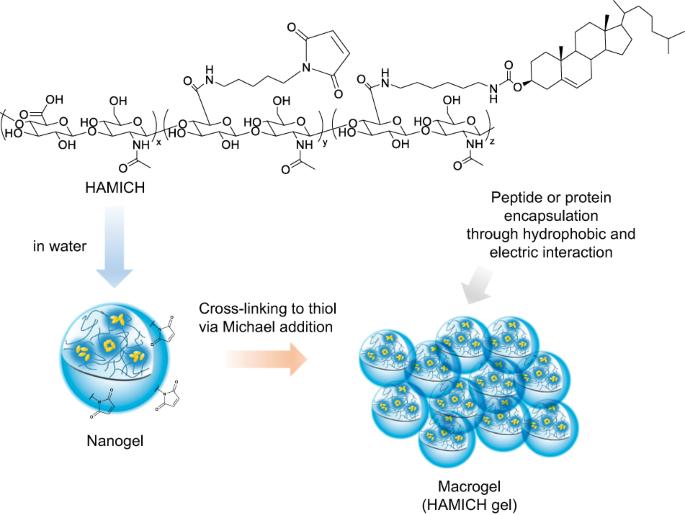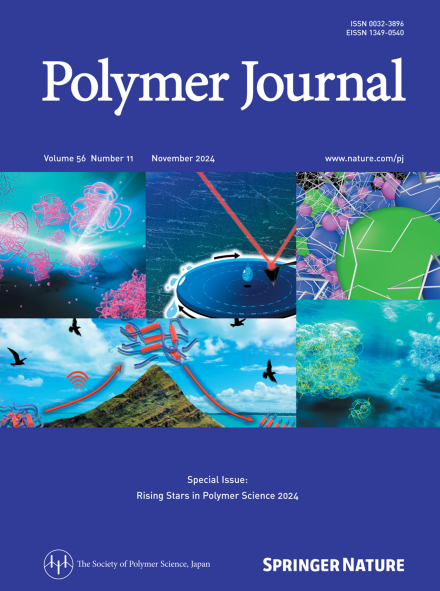Variable swelling behavior of and drug encapsulation in a maleimide-modified hyaluronic acid nanogel-based hydrogel
IF 2.3
4区 化学
Q3 POLYMER SCIENCE
引用次数: 0
Abstract
Hyaluronic acid (HA) has garnered much attention in the development of novel hydrogels. Hydrogels, as drug delivery systems, are very important in tissue engineering applications. In this study, we developed a novel HA nanogel containing a cholesterol and maleimide derivative (HAMICH) and its corresponding crosslinked hydrogel (HAMICH gel) to encapsulate drugs for their subsequent release. HAMICH gels self-assemble into nanoparticles via hydrophobic interactions. Dynamic light scattering analysis of HAMICH revealed that the particle size tended to decrease with increasing degree of cholesterol moiety substitution. The HAMICH gel was prepared through a Michael addition reaction between HAMICH and pentaerythritol tetra(mercaptoethyl)polyoxyethylene. The concentration of HAMICH needed for gelation depends on the degree of cholesterol moiety substitution; the higher the substitution degree is, the greater the concentration of HAMICH needed. The HAMICH gel exhibited less swelling and a smaller volume change than the gel with an unmodified cholesterol moiety in phosphate-buffered saline (pH 7.4). The HAMICH gel displayed enhanced peptide and protein trapping abilities without hydrogel swelling, suggesting its potential as a HA hydrogel for biomedical applications. Hydrogels have attracted considerable attention in the biomedical applications because of their high functionalities, biocompatibility and biodegradability. This study on the novel hyaluronic acid (HA) nanogel-based hydrogel comprising HA modified with cholesterol derivatives and maleimide crosslinking groups. Depending on the degree of cholesterol derivative substitution, the properties such as water uptake, gelation behavior and protein encapsulation was investigated. The results suggested that the hydrogels enhanced peptide and protein trapping abilities have potential as a new hyaluronan hydrogel for biomedical applications.


马来酰亚胺改性透明质酸纳米水凝胶的可变膨胀行为和药物包囊
透明质酸(HA)在新型水凝胶的开发中备受关注。水凝胶作为药物输送系统,在组织工程应用中非常重要。在这项研究中,我们开发了一种含有胆固醇和马来酰亚胺衍生物(HAMICH)的新型 HA 纳米凝胶及其相应的交联水凝胶(HAMICH 凝胶),用于包裹药物并随后释放。HAMICH 凝胶通过疏水相互作用自组装成纳米颗粒。对 HAMICH 的动态光散射分析表明,随着胆固醇分子取代度的增加,粒径呈减小趋势。HAMICH 凝胶是通过 HAMICH 和季戊四醇四(巯基乙基)聚氧乙烯之间的迈克尔加成反应制备的。凝胶化所需的 HAMICH 浓度取决于胆固醇分子的取代程度;取代程度越高,所需的 HAMICH 浓度越大。在磷酸盐缓冲盐水(pH 值为 7.4)中,HAMICH 凝胶比未修饰胆固醇分子的凝胶膨胀更少,体积变化更小。HAMICH 凝胶显示出更强的肽和蛋白质捕获能力,而不会出现水凝胶膨胀,这表明它具有作为 HA 水凝胶用于生物医学应用的潜力。
本文章由计算机程序翻译,如有差异,请以英文原文为准。
求助全文
约1分钟内获得全文
求助全文
来源期刊

Polymer Journal
化学-高分子科学
CiteScore
5.60
自引率
7.10%
发文量
131
审稿时长
2.5 months
期刊介绍:
Polymer Journal promotes research from all aspects of polymer science from anywhere in the world and aims to provide an integrated platform for scientific communication that assists the advancement of polymer science and related fields. The journal publishes Original Articles, Notes, Short Communications and Reviews.
Subject areas and topics of particular interest within the journal''s scope include, but are not limited to, those listed below:
Polymer synthesis and reactions
Polymer structures
Physical properties of polymers
Polymer surface and interfaces
Functional polymers
Supramolecular polymers
Self-assembled materials
Biopolymers and bio-related polymer materials
Polymer engineering.
 求助内容:
求助内容: 应助结果提醒方式:
应助结果提醒方式:


